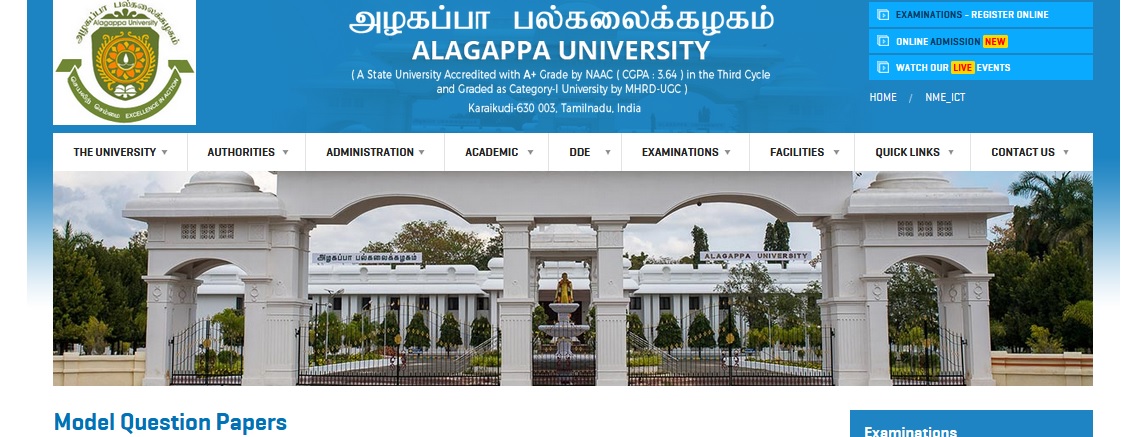Classical And Statistical Mechanics M.Sc Model Question Papers : alagappauniversity.ac.in
Name of the University : Alagappa University
Degree : M.Sc
Department : Physics
Subject Code/Name : Classical And Statistical Mechanics
Document Type : Model Question Papers
Website : alagappauniversity.ac.in
Download Model/Sample Question Paper : Dec 2009 : www.pdfquestion.in/uploads/alagappauniversity.ac.in/4125.-MSC%20(Physics).docx
Alagappa Statistical Mechanics Question Paper
Time : Three hours
Maximum : 100 marks
Answer any FIVE questions. :
Related : Alagappa University Chemistry Of Biopolymers M.Sc Model Question Papers : www.pdfquestion.in/4048.html
Each question carries 20 marks.
1. (a) State and explain D-Alembert’s principle.
(b) Give Hamilton’s principle.
(c) Deduce Hamilton’s principle from D-Alembert’s principle.
2. (a) Explain virtual work.
(b) Derive Lagrange’s equation of motion.
(c) Obtain the Lagrange’s equation of motion for non-conservative system.

3. (a) What are cyclic co-ordinates?
(b) State and explain the principle of least action.
(c) Obtain Hamilton’s equation of motion from variational principle.
4. (a) Give a brief account on canonical transformation.
(b) Show that Poisson bracket is invariant under canonical transformation.
(c) Discuss the Kepler problem in action-angle variables.
5. (a) Write a note on Euler’s angle.
(b) Give an account of angular momentum of a rigid body.
(c) Obtain Hamilton-Jacobi equations.
6. (a) What are normal co-ordinates?
(b) Obtain the normal modes of vibration of a linear triatomic molecule.
(c) Discuss the different modes of vibration of a linear triatomic molecule.
7. (a) Explain micro canonical ensemble.
(b) What is partition function?
(c) State and prove Liouville’s theorem.
8. (a) What is grand canonical ensemble?
(b) Give a note on most probable velocity.
(c) Discuss Maxwell-Boltzmann statistics in detail.
Integrated & Digital Electronics
M.Sc. (Physics) Degree Examination, December 2009 :
: (2008 onwards)
Time : Three hours
Maximum: 100 marks
Answer any FIVE questions. Each question carries 20 marks.
1. (a) Explain class A power amplifier. How power is distributed in it. (6)
(b) What is an audio power amplifier? Explain the difference between a voltage and power amplifier. (6)
(c) Describe the working of Push Pull Amplifier. (8)
2. (a) Explain the working of source follower amplifier in a FET. Calculate its voltage gain. (10)
(b) Write a note on various types of biasing in FET. (5)
(c) What are the performance quantities of power amplifiers? Explain. (5)
3. (a) List the characteristics of an ideal Op-Amp. (4)
(b) Draw the schmatic diagram of an ideal inverting Op-Amp. Calculate its gain. (7)
(c) Explain how the differential equation is solved by Op-Amp with suitable example. (9)
4. Explain the working of Op-Amp as
(a) Differentiator. (6)
(b) Integrator. (6)
(c) Comparator. (8)
5. (a) Give an example of a truth function using NAND and NOR functions. (6)
(b) Prove that . (6)
(c) Simplify the following Boolean function in sum of products using K map . (8)
6. State and prove De Morgan’s theorem. (6)
(a) J-K Master slave flip-flop. (7)
(b) Mod Counters. (7)
7. (a) Explain the internal architecture of 8086 p and discuss the function of different blocks. (10)
(b) Name the different groups of instruction set of p 8085 and explain. (5)
(c) Explain the use of relative addressing mode in a p. Give example. (5)
8. (a) Write a detailed account on fabrication of monolithic Ic’s. (8)
(b) Write a note on Hall effect. (4)
(c) What are solar cells? How they are fabricated. (8)
Electromagnetic Theory
M.Sc. (Physics) Degree Examination, December 2009 :
: (2008 onwards)
Time : Three hours
Maximum : 100 marks
Answer any FIVE questions.
Each question carries 20 marks.
1. (a) Write down Maxwell’s equations in differential and integral forms. (6)
(b) Point out the physical significance of each. (4)
(c) Discuss the propagation of plane electromagnetic waves in an isotropic dielectric medium. Show that Electric and magnetic field vectors, E and H are mutually perpendicular. (10)
2. (a) What are Fresnel’s equations for reflection? (4)
(b) Derive Fresnel’s equations for reflection and refraction of electromagnetic waves at a plane boundary separating two dielectric media. (8)
(c) Discuss the phenomenon of total internal reflection. (8)
3. (a) What is dispersion? Discuss it in the case of gaseous medium having both real and complex refractive index. (4)
(b) Differentiate normal and anomalous dispersion. (4)
(c) Give Lorentz theory of dispersion and show that in the case non-polar dielectrics. . (12)
4. (a) Define wave guide. (2)
(b) ‘‘A wave guide is a high pass filter’’ comment on the validity of this statement. (3)
(c) What are TE, TM, and TEM modes? (3)
(d) Derive expression for field about cut off for a rectangular wave guide in TE model and also in TM model. (12)
5. (a) What are called Alfren waves? (3)
(b) Derive the general equation for the velocity of magneto hydrodynamic waves and find the solution when
(i) propagation vector is to Alfren velocity.
(ii) propagation vector is to Alfren velocity. (10)
(c) In the photosphere, there are hydrogen atoms per cm3. Assuming the field in photosphere to be 1000 gauss, calculate the phase velocity of Alfren waves. (7)
Please give one mark question